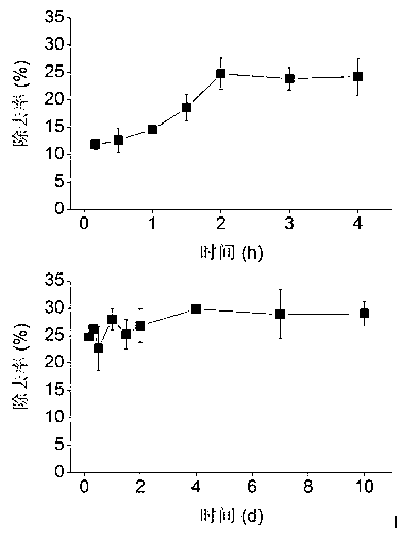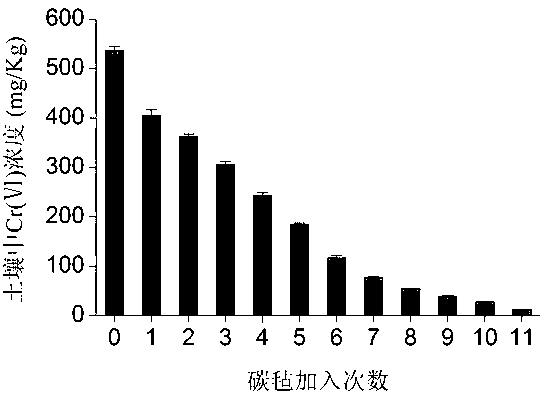Method for rapidly removing and recycling hexavalent chromium from chromium-contaminated soil
A technology of chromium-contaminated soil and hexavalent chromium, applied in the field of environmental pollution restoration, can solve the problems of long time consumption, long time consumption of chemical cleaning, and small biomass
- Summary
- Abstract
- Description
- Claims
- Application Information
AI Technical Summary
Problems solved by technology
Method used
Image
Examples
Embodiment 1
[0017] Example 1: The soil is neutral paddy soil in Xiamen, and chromium is added to the soil in the form of potassium dichromate. The initial concentration of hexavalent chromium is 1000 mg / Kg, and the maximum water content of the soil is kept at 30%. After two months of equilibrium, the concentration of hexavalent chromium in the soil is It is 560 mg / Kg. The carbon material is an inexpensive carbon felt in the industry. Set a carbon felt with a thickness of 0.217 cm and a circle with a diameter of 2.330 cm, soak it in water to make it reach the maximum water content. The carbon felt taken out was buried in the above-mentioned hexavalent chromium-balanced soil, and the thickness of the soil above and below the carbon felt was set to be 1 cm. After putting the carbon felt into the soil for 2 hours, the removal effect of the carbon felt on the soil hexavalent chromium basically reached a balance, and the removal rate was about 25% ( figure 1 ). The removal rate increased s...
Embodiment 2
[0018] Example 2: The operation was as in Example 1, except that different initial chromium concentrations were set. After two months of equilibrium, the hexavalent chromium concentrations in the soil were 25, 135, 375, 560, 578, 1200, and 1472 mg / Kg, respectively. After putting carbon felt into the soil for 24 hours, except that the removal rate of hexavalent chromium in the soil with 25 mg / Kg hexavalent chromium reached 40%, the removal rate of hexavalent chromium in other chromium pollution remained at 30%. %about( figure 2 ). It shows that carbon felt can be applied to the removal of hexavalent chromium in soil with a wide range of chromium pollution levels.
Embodiment 3
[0019] Example 3: The operation was the same as in Example 1, except that the same treatment of chromium-contaminated soil was added several times with carbon felt to remove hexavalent chromium from the soil. With the addition of carbon felt, the concentration of hexavalent chromium in the soil decreased significantly. After 11 additions of carbon felt, the concentration of hexavalent chromium in the chromium-contaminated soil decreased from the initial 560 mg / Kg to 12 mg / Kg ( image 3 ).
PUM
 Login to View More
Login to View More Abstract
Description
Claims
Application Information
 Login to View More
Login to View More - R&D
- Intellectual Property
- Life Sciences
- Materials
- Tech Scout
- Unparalleled Data Quality
- Higher Quality Content
- 60% Fewer Hallucinations
Browse by: Latest US Patents, China's latest patents, Technical Efficacy Thesaurus, Application Domain, Technology Topic, Popular Technical Reports.
© 2025 PatSnap. All rights reserved.Legal|Privacy policy|Modern Slavery Act Transparency Statement|Sitemap|About US| Contact US: help@patsnap.com



